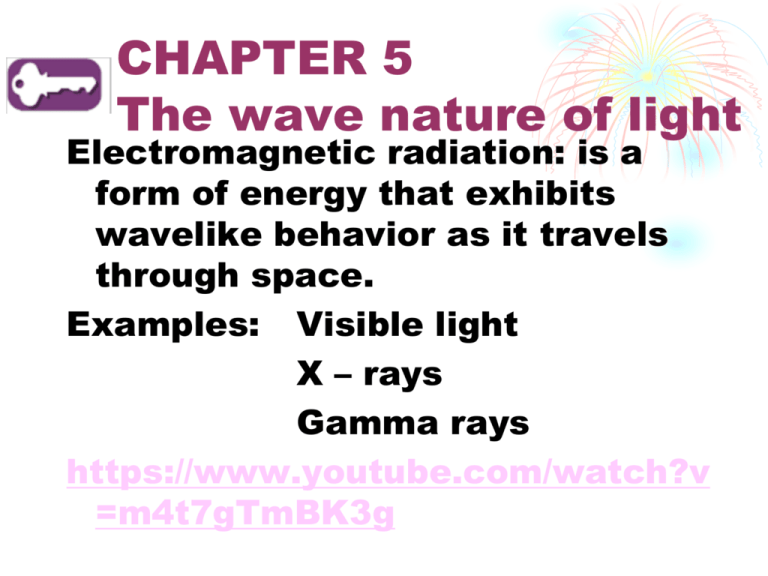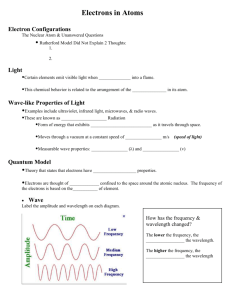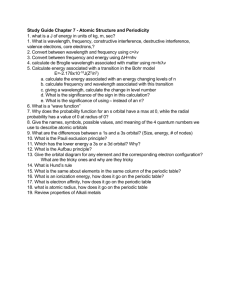Chapter5Powerpoint
advertisement

CHAPTER 5 The wave nature of light Electromagnetic radiation: is a form of energy that exhibits wavelike behavior as it travels through space. Examples: Visible light X – rays Gamma rays https://www.youtube.com/watch?v =m4t7gTmBK3g Electromagnetic spectrum Transverse wave Short wavelength Long Wavelength c = λν All electromagentic waves travel at the speed of light C = 2.99 x 108 m/s (3.0 x 108 m/s) (sound only travels at 340 m/s) c = λν All electromagnetic waves travel at the speed of light C = 2.99 x 108 m/s (3.0 x 108 m/s) (6.7 x 108 miles per hour) (Sound only travels at 340 m/s) Wavelength is in meters Frequency is in hz (1/sec) c = λν 1. What is the frequency of green light, which has a wavelength of 4.90 x 10 -9 m? 2. An X-ray has a wavelength of 1.15 x 10-10 m. What is its frequency? 3. Z100 broadcasts at a frequency of 100.3 MHz. What is the wavelength of the broadcast? (HINT: UNITS) c = λν 4. A compound emits blue light at a wavelength of 4.50 x 10-5cm. What is the frequency of the light? 5. What is the frequency of a wave if its wavelength is 3.6 nm? c = λν 6. Calculate the wavelength of an electromagnetic wave that has a frequency of 1.50 x 1013 Hz. (c = λν) 7. Is the wavelength longer or shorter than red light? E = hv Frequency Energy of a photon (J) (Hz) Plank’s Constant 6.626 x 10 -34 Energy and frequency have a direct relationship High energy = more violet light J•s E = hv h = 6.626 x 10-34 J•s An atom releases blue light with a frequency of 6.8 x 10 12 Hz. What is the energy of the photon emitted? c = λν E = hv 1. Calculate the wavelength of an electromagnetic wave that has a frequency of 1.50 x 1013 Hz. (c = λν) 2. Calculate the energy of the same wave Review: Relationships: Direct or inverse? Wavelength and frequency Frequency and energy Wavelength and energy Emission spectrum Incomplete spectra that are characteristic of a substance (like atom fingerprints) Bohr’s model with the hydrogen atom Bohr Model Electrons are in ‘shells’ Each electron ‘shell’ is quantized (the larger the radius, the larger the energy) Principal Energy levels (n) 1 7 Ground state vs. Excited State Electrons gain energy and jump to higher energy levels = Excited State The excited state is very unstable and the electrons jump back to their previous energy levels releasing a photon (a bundle of energy : LIGHT ENERGY!) Filling order of the first 20 elements: 2, 8, 8, 2 Filling order: For the first 20 elements: 2,8,8,2 For elements 21 – 57: 2,8,18,18,32 For elements 58-114 : 2,8,18,32,32 Valence e- for representative elements Organization of the periodic table: Columns = groups Rows = periods A = representative B = transition Inner transition Organization of the periodic table Rrepresentative elements families: chemical and physical properties are similar 1: Alkali metals –soft metals, very reactive 2: Alkaline metals – reactive metals 15: Pnictogens – Nitrogen column 16: Chalcogens – Oxygen column 17: Halogens – very reactive nonmetals Fluorine: Very reactive and poisonous Chlorine: Yellow – green gas Bromine: Redish-brown liquid 18: Noble gases – very UNreactive gases Quantum Mechanical Model – ‘electron cloud’ • Based on the quantum theory, which says matter has wave-like properties • According to quantum theory, it’s impossible to know the exact position of an electron (Heisenberg’s Uncertainty Principle) https://www.youtube.com/watch?v=TQKE LOE9eY4 Quantum Mechanical model – ‘electron cloud’ (cont) https://ww The model uses complex shapes called orbitals (volumes of space in which there is likely to be an electron) w.youtube .com/watc h?v=cPDp tc0wUYI Principal energy level (n) Sublevels ________ ________ ________ ________ Sublevels ___S___ # orbitals _____ ___P__ __D___ __F__ _____ _____ _____ Orbital = the most probable location for an electron (90%) Shapes of s, p, and dOrbitals s orbital p orbitals d orbitals Each orbital can hold _____ electrons # of electrons all together: _____ _____ _____ _____ Ground State - Electron configuration “Address” for an atoms electrons: nLe Aufbau principle: electrons occupy the lowest energy orbit available in each principal energy level first Every principal energy level adds 1 new sublevel Total number of electrons possible on each sublevel = 2n2 Periodic Patterns • Example - Hydrogen 1 2 3 4 5 6 7 1 1s 1st Period 1st column of s-block s-block Courtesy Christy Johannesson www.nisd.net/communicationsarts/pages/chem Energy levels Overlap 4s3d4p 6s4f5d6p Valence Electrons : • The valence electrons are the electrons in the outermost principal energy level. (Last energy level on the bohr model) • They are always ‘s’ or ‘s and p’ orbital electrons • There can be no more than 8 valence electrons Other electrons are called ‘kernel’ electrons Carbon = 1s2 2s2 2p2 Kernel/core Valence Shorthand / Noble gas notation • Example -Calcium Noble gas that precedes element 1 2 3 4 5 6 7 2 [Ar]4s 4th Period 2nd column s-block Courtesy Christy Johannesson www.nisd.net/communicationsarts/pages/chem Orbital diagrams Uses boxes and arrows to represent electrons Aufbau principle: electrons occupy the lowest energy orbit available in each principal energy level first Orbital diagrams Uses boxes and arrows to represent electrons Pauli Exclusion principle: each electron in an orbital must have a different spin (one up, one down) Hund’s rule: Electrons repel each other so they must be distributed: single electrons occupy each orbital before electron pairs can be made







